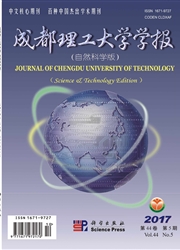

 中文摘要:
中文摘要:
野外地质调查发现,在羌塘盆地中央隆起带及其两侧的南、北羌塘拗陷中,那底岗日组及其同沉积地层之下广泛发育了一套古风化壳,古风化壳覆盖了石炭系、二叠系以及前人已确定的三叠系肖茶卡组,具有区域性展布的特点。结合在那底岗日组底部识别出来的底砾岩,证实了那底岗日组与下伏地层之间存在沉积间断。那底岗日组的沉积标志着新一轮盆地演化的开启。取自北羌塘中部胜利河地区英安岩SHRIMP锆石U-Pb年龄为(217.1±4.9)Ma,北羌塘西部冈玛错地区辉绿岩角闪石的40Ar/39Ar坪年龄为(197±4)Ma。结合近年来在羌塘盆地东部以及西部地区获得的那底岗日组火山岩喷发年龄,表明羌塘盆地那底岗日组火山岩的喷发年龄为205~220Ma,这一年龄也代表了羌塘中生代盆地的开启年龄。那底岗日组火山岩具有高的Nb/Zr(0.039~0.058),Ta/Hf(0.095~0.15)和Zr/Y(3.57~6.01)比值,在构造环境判别图(如Zr-Zr/Y和Th/Hf-Ta/Hf)上,那底岗日组火山岩大多位于板内玄武岩区。结合中生代盆地早期沉积演化特征,认为羌塘中生代盆地形成于伸展的构造环境。
 英文摘要:
英文摘要:
Abstract: A new paleo-weathering crust occurred at the top of Carboniferous and Permian strata and Xioachaka Formation was discovered in the central uplift of the Qiangtang basin, the north Qiangtang depression and the south Qiangtang depression during field investigation of petroleum geology. It indicates a regional distribution. Combined with the basal conglomerate observed on the bottom o{the Nadi Kangri Formation, this paper confirms that a sedimentary hiatus probably exists between the Nadi Kangri and underlying strata. Therefore, the Nadi Kangri strata represent a new history of the Mesozoic Qiangtang basin, and the age of the Nadi Kangri volcanic rocks represents the onset of the Mesozoic Qiangtang basin. The dacite from the middle part of the north Qiangtang basin (the Shengli River area) gives a SHRIMP zircon U Pb age of (217.1±4.9) Ma, which represents an eruption age of the Nadi Kangri volcanic rocks in this area. Additionally, the results of this study show that the 40Ar/39Ar plateau age of the diabase from the Gangma Co area (the west part of the north Qiangtang basin) is 197±4 Ma. Previously the authors also obtained SHRIMP zircon U-Pb ages o- the Nadi Kangri volcanic rocks from the east, the west, and the middle parts of the Qiangtang basin. They are (220.4±2.3) Ma, 2084225 Ma, 205-220 Ma, respectively. This indicates that the eruption age of the Nadi Kangri volcanic rocks in the Qiangtang basin is about 205 -220 Ma. These data show that the onset of the Mesozoic Qiangtang basin should be the Late Triassic time (about 205 - 220 Ma B.P.). The Nadi Kangri basalts have high Nb/Zr (0.039-0.058), Ta/Hf (0. 095-0.15) andZr/Y (3.57-6.01) ratios. In the tectonic discrimination diagrams, such as Zr vs. Zr/Y and Th/Hf vs. Ta/Hf, the Nadi Kangri basaltic rocks mostly plot in the "within-plate" setting field. Taking the early sedimentary history into account, the authors conclude that the Mesozoic Qiangtang basin formed in an extensional setting.
 同期刊论文项目
同期刊论文项目
 同项目期刊论文
同项目期刊论文
 Origin and mode of occurrence of trace elements in marine oil shale from the Shengli River area, nor
Origin and mode of occurrence of trace elements in marine oil shale from the Shengli River area, nor Geochemistry of platinum group elements in marine oil shale from the Changshe Mountain area (China):
Geochemistry of platinum group elements in marine oil shale from the Changshe Mountain area (China): Trace elements and their behaviour during the combustion of marine oil shale from Changliang Mountai
Trace elements and their behaviour during the combustion of marine oil shale from Changliang Mountai Source regions and the sedimentary paleoenvironment of marine oil shale from the Bilong Co area, nor
Source regions and the sedimentary paleoenvironment of marine oil shale from the Bilong Co area, nor 期刊信息
期刊信息
